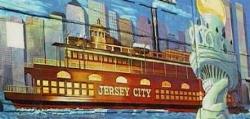 |  |  |
|
| ||
 |  |  |
 |  |  |
|
| ||
 |  |  |
|
|
By Glenn L. Jepsen
Edited by GET NJ, COPYRIGHT 2003
Why is the mastodon now as extinct as the dodo and the Passenger
pigeon? No one really knows why,
but professional as well as amateur
paleontologists have made many
guesses about the cause of its disappearance. Until recently some
people imagined that a few mastodons might even now be tramping
and trumpeting through the woods
in unexplored areas of North and
South America. In the 1780's President Jefferson was firm in his belief
that no race of animals was ever lost
from "nature's chain," and he cited
as evidence the stories of some Indians about living mastodons in the
northern and western parts of North
America. These Indians told tales
about ancient battles, which their
ancestors had witnessed, between
giant beasts, and also reported
that parts of the trunks and other
fleshy hits of big animals could be
found buried near the surface under
leaves and thin layers of dirt.
Most of these claims were inspired by wishful thinking or by efforts
to please an audience through the
invention of interesting myths about
creatures that had obviously excited
the imaginations of white men who
were eager to explore the wilderness
and to see and collect its animal
treasures.
The truth is as remarkable as the
lies. It is true that Indians and mastodons and giant beavers and ground
sloths and mammoths and sabre-toothed "tigers" and camels and extinct kinds of horses and bison all
lived at the same time in America
some thousands of years ago. Indian
artifacts have been found with the
bones of these animals as well as
others which have also vanished
from the face of the earth. In Texas,
California, Tennessee, Florida, and
New Mexico there are evidences that
man and mastodon knew and slew
each other, and this was probably
true in many parts of the forests of
North America. Mastodon meat,
either roasted or raw, may have been
a delicious treat that was well worth
the effort and the difficulties of the
kill.
How long ago? Chemical tests of
the age of American mastodon tusks
or of wood found close to mastodon
bones in Ohio, Indiana, and Mich-
igan indicate that the animals were
living as recently as 5,000 to 10,000 years ago. Archeologists have
debated for many years about the
age, nature, and meaning of ancient
rock carvings in Asia and America
that seem to represent mastodons and
mammoths. In Europe the cave artist
of about 25,000 to 12,000 years ago
depicted the mammoth with a curiously "bombed" or elevated skull
and with long hair on its belly.
When the caves were discovered and
explored by modern man these features were believed to be mere exag-
gerations, the result of artistic license. Frozen carcasses of mammoths, found in Siberia, proved that
the murals were true to life, natural
and accurate.
Most everyone now agrees that the
mastodons are all gone, but the cause
of their demise isn't clear and it may
have been the result of many factors
combined. Disease and epidemics
have been suggested as a cause, but
there is no clear evidence for this,
nor are there any indications that
giant bears (the supergrizzlies) or
other kinds of natural enemies could
have destroyed the mastodon. Other
suggested causes which can't be
proved include catastrophes or cataclysms such as a sudden shift of the
poles, quick or extreme changes of
climate, insufficient food, intense
cold, poison plants, lack of adaptation to changing conditions, slow
locomotion, overgrowth of tusks,
thinning skin, various deforming
genetic effects, fire drives by Indians,
blood sucking or stinging or poison
insects, great floods (including the
mythical submergence in the Biblical
story), warfare among themselves,
and so on. No one really knows, and
perhaps we will never know.
|
|
| 08/18/2012 11:10 PM |
|
Computer Repair Blog XP Local Area Connection stuck at Acquiring Network Address |
 Your Ancestors' Story |
 Bruce Springsteen's Jersey Shore Rock Haven! |

|
UrbanTimes.com |